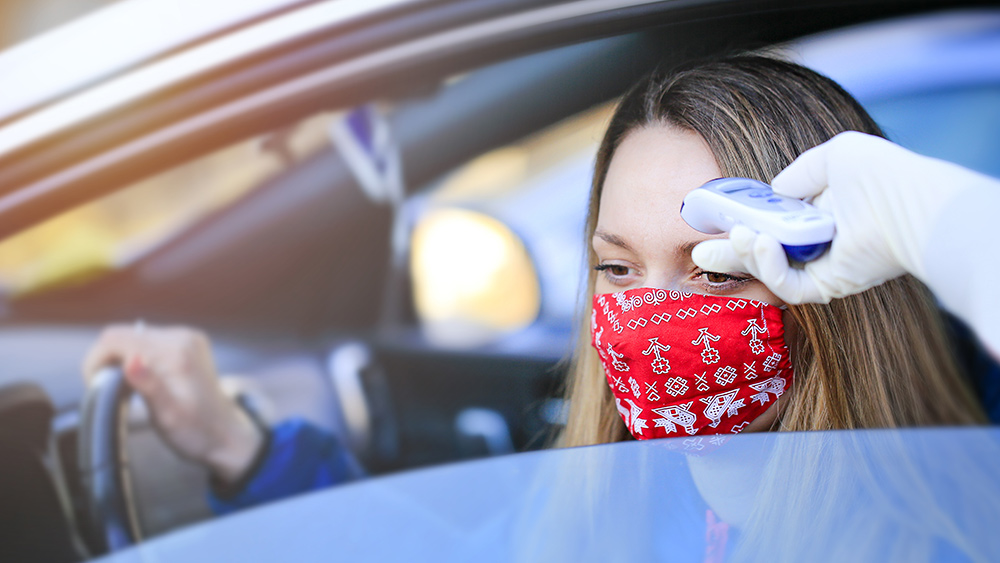
Due to the lockdown policies being implemented throughout the U.S., businesses have closed down and the unemployment rate has skyrocketed to alarming highs.
Households are desperate to have food to provide for their families.
Citizens from Los Angeles, Pennsylvania and New Jersey are now traveling miles to receive food bank handouts during the pandemic.
Los Angeles and Pennsylvania
On April 28, hundreds of Americans lined up to receive food handouts in L.A. and Prospect, Pennsylvania.
Countless cars could be seen waiting in line for the drive-thru food giveaway in Pico Rivera, California. Hard-working volunteers with face masks, gloves and high-visibility jackets were tasked with giving out supplies.
Images showed people in L.A. waiting in cars lined up along the edge of empty basketball courts and a football field at Ruben Salazar High School.
An aerial photo also revealed an abandoned community pool. Instead of cooling off at the pool, the crowds were gathered in the area to wait before they could enter the food bank area.
Volunteers from the L.A. Regional Food Bank and the city passed gallons of milk through car windows at the event. One of the volunteers held up a sign to remind drivers to open their trunks so volunteers can put bags and boxes of food in the cars and avoid unnecessary contact.
L.A. County is suffering the brunt of the coronavirus pandemic economically. Reports say 47 percent of jobs in the area are at risk at since, especially since 69 percent of jobs can't be done from home.
In Prospect, vehicles stretched as far as the Big Butler Fairgrounds. Volunteers are expecting over 1,500 cars bearing people who will receive two 25-pound boxes of food every Tuesday. Another aerial image captured hundreds of cars lined up at the Greater Pittsburgh Community Food Bank.
Early in May, 3.2 million Americans have filed for unemployment claims.
The worrying increase in unemployment has negated all of the jobs gained during the longest employment boom in American history. Due to the repercussions of the pandemic, economists have issued warnings that the unemployment rate could surge by about 20 percent for April, which will be the highest rate since the Great Depression of the 1930s.
On April 28, California Governor Gavin Newsom declared that a number of workplaces, schools and childcare facilities can gradually reopen after the state enhances coronavirus testing and contact tracing. While other states have started easing up on lockdown rules, Newsom insisted on the stay-at-home order for the state until recently.
He explained the state's steps for reopening, insisting that California is weeks away from being able to lift coronavirus restrictions. But even as rates of infections have slowed in certain areas of California, Los Angeles County was the hardest-hit area.
Official figures released on May 14 revealed that the death toll in Los Angeles County reached 1,659, with 34,428 confirmed cases.
Within L.A. County, the rate of deaths and infections has accelerated. About 315 people have died, with 7,218 confirmed new cases for the seven-day period that ended on April 26.
Pennsylvania was also one of the states that kept its stay-at-home order in place. The executive order ran until April 30. As of April 28, the state recorded 1,716 deaths and 43,264 confirmed cases of COVID-19. (Related: Coronavirus continues to ravage cities and the U.S. food chain: Here are five ways food security could COLLAPSE.)
New Jersey
Jean Wickham, a 55-year-old from New Hersey, has two sons in college. Her husband has worked at the same casino in the state for 36 years. But when the coronavirus pandemic hit New Jersey, every casino in Atlantic City closed, putting over 26,000 people out of work. The total makes up 10 percent of the county’s population.
Wickham, who has had a job since she was 14, is at a loss. She and her family have never had to rely on others until the pandemic. Wickham drove the family's minivan to Egg Harbor, N.J., 10 miles west of Atlantic City. Their car was only one of the thousands of vehicles that set out to receive fresh produce and a 30-pound box of canned food, pasta and rice from a food bank.
The event was held last week and was mobbed by so many cars that traffic was backed up for almost a mile in three directions. Police reports recorded five accidents.
Data from a Monmouth University poll released on April 27 revealed that out of over 40 percent of households in New Jersey, at least one individual has lost his job due to the coronavirus pandemic.
Despite living in one of America's wealthiest states, many suddenly unemployed workers report that they have been “pushed to the edge of hunger.”
In Summit, an affluent commuter town in northern New Jersey, the lines at a food pantry wound around the block every Tuesday evening. Meanwhile, a food bank on the Jersey Shore has started a text service so new users can discreetly ask for help.
The Community Food Bank of New Jersey gave away at least 1,500 emergency meal kits that provide supplemental food for a family of four for about 14 days. The distribution to casino workers was over in under three hours, but several additional truckloads of food had to be brought to the site to accommodate more people.
Sgt. Larry Graham, leader of the Egg Harbor Township Police Department’s traffic division, said another 1,500 cars were turned away.
The Community Food Bank, the state’s largest provider of emergency food, explained that this surge in demand has surpassed those that followed Hurricane Sandy and the Great Recession, which ended in 2009.
New Jersey, considered the second-wealthiest state in the U.S., had 858,000 residents file for unemployment benefits on April 23 -- a staggering increase from 84,000 for the same time period in 2019. Worse, this figure is likely to increase even further.
According to a recent study by Stockton University, the pandemic’s drain on the economy in southern New Jersey could amount to $5.1 billion this year.
Pandemic.news has the latest updates on the COVID-19 pandemic in the U.S. and around the globe.
Sources include:
Please contact us for more information.























